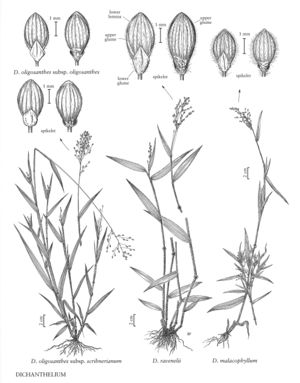Dichanthelium ravenelii
Plants cespitose, with caudices. Basal rosettes well-differentiated; blades 3-8 cm, ovate to lanceolate. Culms 25-75 cm, 2-3 mm thick, erect, purplish; nodes densely bearded with spreading to retrorse hairs above a glabrous ring; internodes pilose or ascending hirsute, hairs papillose-based, also puberulent; fall phase with nearly erect culms, branching from the mid and upper culm nodes; branches short, ascending, bushy, with several reduced, partly enclosed secondary panicles. Cauline leaves 4-6; sheaths not overlapping, papillose-hirsute and puberulent; collars densely pubescent; ligules 2-5 mm, of hairs; blades 8-17 cm long, 8-18 mm wide, lanceolate, stiff, thick, abaxial surfaces densely soft-pubescent, velvety, adaxial surfaces glabrous or sparsely pilose, with 9-11 major veins slightly more prominent than the minor veins, bases rounded or subcordate, margins with papillose-based cilia, apices acuminate. Primary panicles 5-11 cm, almost as wide as long, shortly exserted, with few spikelets; rachises and branches scabridulous and finely pubescent, hairs papillose-based. Spikelets 3.7-4.3 mm long, 1.6-2.1 mm wide, obovoid, turgid, often shiny, sparsely pustulose-villous. Lower glumes 1.8-2.5 mm, loose, strongly veined, acute; upper glumes shorter than the spikelets, strongly veined, purplish at the base; lower florets sterile; upper florets with a minute tuft of hairs around the umbonate apices. 2n = 18.
Distribution
Md., Okla., Miss., Tex., La., Mo., Del., Ala., D.C., Tenn., N.C., S.C., Va., Ark., Ill., Ga., Iowa, Ky., Fla.
Discussion
Dichanthelium ravenelii grows in dry, sandy wood¬lands of the southeastern United States. The primary panicles develop from early May through June, and are at least partly open-pollinated. The secondary panicles, which are produced from July through September, are cleistogamous. Putative hybrids with other species are very rare.
Selected References
None.
Lower Taxa
No values specified."usually distinctly longer and narrower" is not a number."decumbent" is not a number.
